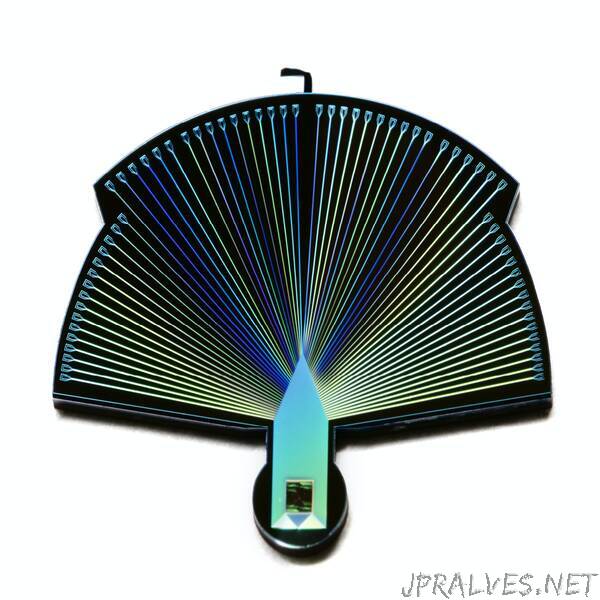
“Researchers use a superconducting nanowire design for fast and precise photon counting
Researchers have developed a new detector that can precisely measure single photons at very high rates. The new device could help make high-speed quantum communication practical.
Quantum communication uses light at the single photon level to send encoded quantum information such as encryption keys in quantum key distribution. Because of the laws of physics, data transmitted in this way is guaranteed to remain secure. Sending information at faster speeds requires a single photon detector that can not only detect photons quickly but also precisely measure their arrival times.
In Optica, Optica Publishing Group’s journal for high-impact research, researchers led by Matthew D. Shaw at NASA’s Jet Propulsion Laboratory describe and demonstrate their new detector for measuring the arrival times of photons, which they call PEACOQ (performance-enhanced array for counting optical quanta) detector.
“Our new detector is made of 32 niobium nitride superconducting nanowires on a silicon chip, which enables high count rates with high precision,” said research team member Ioana Craiciu, a postdoctoral scholar. “The detector was designed with quantum communication in mind, as this is a technological area that has been limited by the performance of available detectors.”
The detector was developed as part of a NASA program to enable new technology for space-to-ground quantum communication, which can allow sharing of quantum information across intercontinental distances in the future. This work builds upon technology developed for the NASA Deep Space Optical Communication project, which will be the first demonstration of free-space optical communication from interplanetary space.
“There is not currently another detector that can count single photons this quickly with the same timing resolution,” said Craiciu. “We know this detector will be useful for quantum communication, but we also hope that it could enable other applications that we haven’t considered.”
Faster quantum communication
Speeding up quantum communication transmission rates requires a detector on the receiving end that can make quick measurements and exhibits a short dead time so that it can contend with a high rate of arriving photons. The detector must also precisely measure the arrival time of the photons.
“Although there are detectors that can measure photon arrival times with high precision they struggle to keep up when the photons are arriving in quick succession and can miss some of the photons or get their arrival times wrong,” said Craiciu. “We designed the PEACOQ detector to precisely measure the arrival times of single photons even as they are hitting the detector at a high rate. It is also efficient – it doesn’t miss many of the photons.”
The PEACOQ detector is made of nanowires just 7.5 nm thick, or about 10,000 times thinner than a human hair. Operating it at very cold temperatures — around 1 Kelvin, or -458 °F — makes the nanowires superconducting, which means they have no electrical resistance. Under superconducting conditions, any photon that hits a wire has a good chance of being absorbed by that wire. Any absorbed photons create a hot spot that increases the wire’s electrical resistance in a detectable way. A computer along with a time-to-digital converter is used to record when the resistance changed and thus when a photon arrived at the detector.
“When the detector measures a photon, it outputs an electric pulse, and the time-to-digital converter measures the arrival time of this electrical pulse very precisely, with a resolution below 100 picoseconds or 70 million times faster than a snap of the fingers,” said Craiciu. “We developed a new time-to-digital converter that can measure up to 128 channels at once with this timing resolution, which is important because our detector needs 32 channels.”
To demonstrate the new detector, the researchers cooled it down to 1 Kelvin by installing it in a cryostat. They used a custom-built testing setup to send light into the cryostat to the detector and a chain of electronics to transmit the detector’s output signal out of the cryostat, amplify it and record it. Because there are 32 nanowires, the researchers had to use 32 sets of each component, including 32 cables and 32 of each kind of amplifier.
Unprecedented count rates
“We were very pleased with how well the detector worked,” said Craiciu. “The rate at which it can measure photons was the highest we have seen. It requires a complex setup because each of the 32 nanowires is read out individually, but for applications where you really need to measure photons at a high rate with high precision, it is worth the trouble.”
Typically, quantum information being transmitted is set to a clock, with each piece of information encoded into one photon and sent on a tick. How precisely you can measure the arrival time of the photons at the receiver determines how close together the ticks can be without making a mistake, and therefore it determines how quickly you can send the information. The new detector makes it practical to perform quantum communication with a state-of-the-art clock frequency of 10-GHz.
The researchers are still working to make improvements to the PEACOQ detector, which is currently about 80% efficient — meaning 20% of photons that hit the detector are not measured. They also plan to build a portable receiver unit that can be used for quantum communication experiments. It will contain several PEACOQ detectors along with optics, readout electronics and a cryostat.
Paper: I. Craiciu, B. Korzh, A. D. Beyer, A. Mueller, J. P. Allmaras, L. Narvaez, M. Spiropulu, B. Bumble, T. Lehner, E. E. Wollman, M. D. Shaw, “High-speed detection of 1550 nm single photons with superconducting nanowire detectors,” 10, 2, 183-190 (2023).
DOI: https://doi.org/10.1364/OPTICA.478960.”
